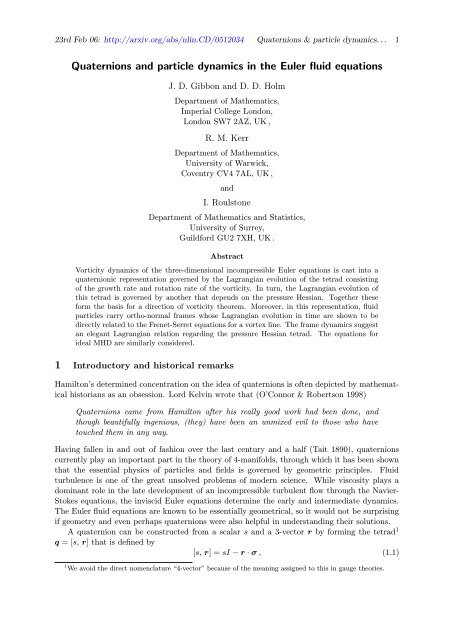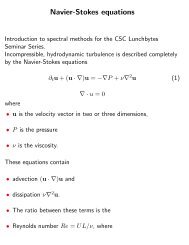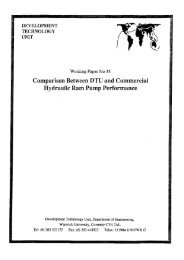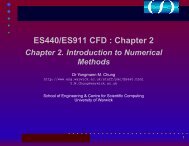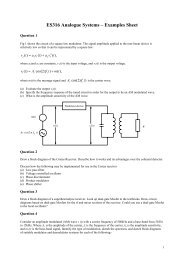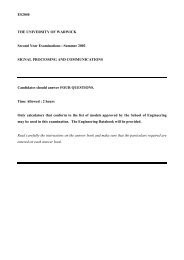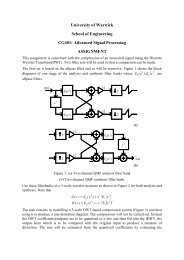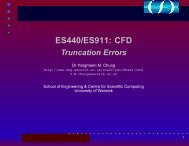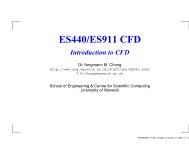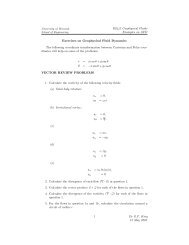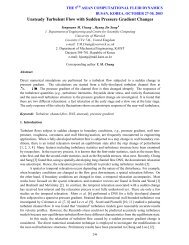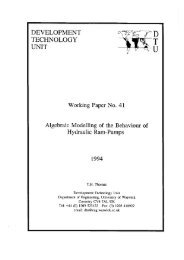Quaternions and particle dynamics in the Euler fluid equations
Quaternions and particle dynamics in the Euler fluid equations
Quaternions and particle dynamics in the Euler fluid equations
Create successful ePaper yourself
Turn your PDF publications into a flip-book with our unique Google optimized e-Paper software.
23rd Feb 06: http://arxiv.org/abs/nl<strong>in</strong>.CD/0512034 <strong>Quaternions</strong> & <strong>particle</strong> <strong>dynamics</strong>. . . 1<br />
<strong>Quaternions</strong> <strong>and</strong> <strong>particle</strong> <strong>dynamics</strong> <strong>in</strong> <strong>the</strong> <strong>Euler</strong> <strong>fluid</strong> <strong>equations</strong><br />
J. D. Gibbon <strong>and</strong> D. D. Holm<br />
Department of Ma<strong>the</strong>matics,<br />
Imperial College London,<br />
London SW7 2AZ, UK ,<br />
R. M. Kerr<br />
Department of Ma<strong>the</strong>matics,<br />
University of Warwick,<br />
Coventry CV4 7AL, UK ,<br />
<strong>and</strong><br />
I. Roulstone<br />
Department of Ma<strong>the</strong>matics <strong>and</strong> Statistics,<br />
University of Surrey,<br />
Guildford GU2 7XH, UK .<br />
Abstract<br />
Vorticity <strong>dynamics</strong> of <strong>the</strong> three-dimensional <strong>in</strong>compressible <strong>Euler</strong> <strong>equations</strong> is cast <strong>in</strong>to a<br />
quaternionic representation governed by <strong>the</strong> Lagrangian evolution of <strong>the</strong> tetrad consist<strong>in</strong>g<br />
of <strong>the</strong> growth rate <strong>and</strong> rotation rate of <strong>the</strong> vorticity. In turn, <strong>the</strong> Lagrangian evolution of<br />
this tetrad is governed by ano<strong>the</strong>r that depends on <strong>the</strong> pressure Hessian. Toge<strong>the</strong>r <strong>the</strong>se<br />
form <strong>the</strong> basis for a direction of vorticity <strong>the</strong>orem. Moreover, <strong>in</strong> this representation, <strong>fluid</strong><br />
<strong>particle</strong>s carry ortho-normal frames whose Lagrangian evolution <strong>in</strong> time are shown to be<br />
directly related to <strong>the</strong> Frenet-Serret <strong>equations</strong> for a vortex l<strong>in</strong>e. The frame <strong>dynamics</strong> suggest<br />
an elegant Lagrangian relation regard<strong>in</strong>g <strong>the</strong> pressure Hessian tetrad. The <strong>equations</strong> for<br />
ideal MHD are similarly considered.<br />
1 Introductory <strong>and</strong> historical remarks<br />
Hamilton’s determ<strong>in</strong>ed concentration on <strong>the</strong> idea of quaternions is often depicted by ma<strong>the</strong>matical<br />
historians as an obsession. Lord Kelv<strong>in</strong> wrote that (O’Connor & Robertson 1998)<br />
<strong>Quaternions</strong> came from Hamilton after his really good work had been done, <strong>and</strong><br />
though beautifully <strong>in</strong>genious, (<strong>the</strong>y) have been an unmixed evil to those who have<br />
touched <strong>the</strong>m <strong>in</strong> any way.<br />
Hav<strong>in</strong>g fallen <strong>in</strong> <strong>and</strong> out of fashion over <strong>the</strong> last century <strong>and</strong> a half (Tait 1890), quaternions<br />
currently play an important part <strong>in</strong> <strong>the</strong> <strong>the</strong>ory of 4-manifolds, through which it has been shown<br />
that <strong>the</strong> essential physics of <strong>particle</strong>s <strong>and</strong> fields is governed by geometric pr<strong>in</strong>ciples. Fluid<br />
turbulence is one of <strong>the</strong> great unsolved problems of modern science. While viscosity plays a<br />
dom<strong>in</strong>ant role <strong>in</strong> <strong>the</strong> late development of an <strong>in</strong>compressible turbulent flow through <strong>the</strong> Navier-<br />
Stokes <strong>equations</strong>, <strong>the</strong> <strong>in</strong>viscid <strong>Euler</strong> <strong>equations</strong> determ<strong>in</strong>e <strong>the</strong> early <strong>and</strong> <strong>in</strong>termediate <strong>dynamics</strong>.<br />
The <strong>Euler</strong> <strong>fluid</strong> <strong>equations</strong> are known to be essentially geometrical, so it would not be surpris<strong>in</strong>g<br />
if geometry <strong>and</strong> even perhaps quaternions were also helpful <strong>in</strong> underst<strong>and</strong><strong>in</strong>g <strong>the</strong>ir solutions.<br />
A quaternion can be constructed from a scalar s <strong>and</strong> a 3-vector r by form<strong>in</strong>g <strong>the</strong> tetrad 1<br />
q = [s, r] that is def<strong>in</strong>ed by<br />
[s, r] = sI − r ∙ σ , (1.1)<br />
1 We avoid <strong>the</strong> direct nomenclature “4-vector” because of <strong>the</strong> mean<strong>in</strong>g assigned to this <strong>in</strong> gauge <strong>the</strong>ories.
23rd Feb 06: http://arxiv.org/abs/nl<strong>in</strong>.CD/0512034 <strong>Quaternions</strong> & <strong>particle</strong> <strong>dynamics</strong>. . . 2<br />
where r ∙ σ = ∑ 3<br />
i=1 r iσ i <strong>and</strong> I is <strong>the</strong> 2 × 2 unit matrix. {σ 1 , σ 2 , σ 3 } are <strong>the</strong> Pauli sp<strong>in</strong> matrices<br />
( )<br />
( )<br />
( )<br />
0 i<br />
0 1<br />
i 0<br />
σ 1 = , σ<br />
i 0<br />
2 =<br />
, σ<br />
−1 0<br />
3 =<br />
, (1.2)<br />
0 −i<br />
that obey <strong>the</strong> relations σ i σ j = −δ ij − ɛ ijk σ k . A multiplication rule can easily be determ<strong>in</strong>ed<br />
from <strong>the</strong>se properties<br />
q 1 ⊗ q 2 = [s 1 s 2 − r 1 ∙ r 2 , s 1 r 2 + s 2 r 1 + r 1 × r 2 ] . (1.3)<br />
This shows that quaternions are not commutative, although it is easily demonstrated that <strong>the</strong>y<br />
are associative. They are found to be extremely useful <strong>in</strong> modern <strong>in</strong>ertial navigation systems,<br />
robotics & graphics that control or track rapidly mov<strong>in</strong>g objects undergo<strong>in</strong>g three-axis rotations<br />
(Kuipers 1999). In fact, Hamilton discovered <strong>the</strong>m <strong>in</strong> <strong>the</strong> context of an algorithm for rotat<strong>in</strong>g<br />
<strong>the</strong> telescope <strong>in</strong> his observatory. If Kelv<strong>in</strong> were alive today, he might be forced to revise his<br />
negative op<strong>in</strong>ion of <strong>the</strong>ir importance.<br />
Given <strong>the</strong> evidence, it is natural to reformulate <strong>Euler</strong> vorticity <strong>dynamics</strong> <strong>in</strong> terms of quaternions,<br />
particularly <strong>in</strong> track<strong>in</strong>g a <strong>fluid</strong> <strong>particle</strong> that carries its own ortho-normal co-ord<strong>in</strong>ate<br />
system <strong>in</strong> motion. Instead of sett<strong>in</strong>g <strong>Euler</strong> variables <strong>in</strong> st<strong>and</strong>ard function spaces, <strong>in</strong> which delicate<br />
geometric <strong>in</strong>formation might be lost, <strong>the</strong> pr<strong>in</strong>cipal aim of this paper is to <strong>in</strong>vestigate <strong>the</strong><br />
Lagrangian evolution of <strong>the</strong>se variables <strong>in</strong> appropriate quaternionic form <strong>in</strong> order to preserve<br />
<strong>the</strong>ir <strong>in</strong>herent geometric properties.<br />
Three-dimensional <strong>Euler</strong> vorticity growth is driven by <strong>the</strong> stretch<strong>in</strong>g vector ω ∙ ∇u. This<br />
term plays a fundamental role <strong>in</strong> determ<strong>in</strong><strong>in</strong>g whe<strong>the</strong>r or not a s<strong>in</strong>gularity forms <strong>in</strong> f<strong>in</strong>ite time.<br />
Major computational studies can be found <strong>in</strong> Brachet et al. (1983, 1992); Pumir & Siggia (1990);<br />
Kerr (1993, 2005); Grauer et al. (1998), Pelz (2001) <strong>and</strong> Hou & Li (2006). The Beale-Kato-<br />
Majda <strong>the</strong>orem (Beale et al. 1982) has been <strong>the</strong> ma<strong>in</strong> cornerstone of <strong>Euler</strong> analysis : it makes<br />
<strong>the</strong> precise statement that ∫ t<br />
0 ‖ω‖ L ∞ (D)dτ must be f<strong>in</strong>ite to prevent s<strong>in</strong>gular behaviour on a<br />
doma<strong>in</strong> D. However, it has become clear that not only <strong>the</strong> magnitude but also <strong>the</strong> direction<br />
of vorticity is important. The papers by Constant<strong>in</strong> (1994), Constant<strong>in</strong> et al. (1996); Cordoba<br />
& Fefferman (2001); Deng et al. (2004, 2005) <strong>and</strong> Dongho Chae (2003, 2005) are variations on<br />
this <strong>the</strong>me. Shnirelman (1997) has constructed very weak solutions which have some realistic<br />
features but whose k<strong>in</strong>etic energy monotonically decreases <strong>in</strong> time <strong>and</strong> which are everywhere<br />
discont<strong>in</strong>uous <strong>and</strong> unbounded. For work on <strong>Euler</strong> limits see Brenier (1999, 2000) <strong>and</strong> for its<br />
<strong>dynamics</strong> <strong>in</strong> <strong>the</strong> more exotic function spaces see <strong>the</strong> papers by Tadmor (2001) <strong>and</strong> Dongho Chae<br />
(2003, 2004). O<strong>the</strong>r material, references <strong>and</strong> a more global perspective on <strong>the</strong> <strong>Euler</strong> <strong>equations</strong><br />
can be found <strong>in</strong> <strong>the</strong> book by Majda <strong>and</strong> Bertozzi (2001).<br />
The language of quaternions provides us with an alternative <strong>and</strong> unique look at <strong>the</strong> problem<br />
of <strong>Euler</strong> vortex <strong>dynamics</strong>. The pr<strong>in</strong>cipal results of this paper can be summarized as follows:<br />
1. A well-known variable is <strong>the</strong> scalar growth rate α = ˆω ∙ S ˆω (Constant<strong>in</strong> 1994). Associated<br />
with this is <strong>the</strong> 3-vector rotation rate χ = ˆω × S ˆω , where ˆω is <strong>the</strong> unit vorticity <strong>and</strong><br />
S = 1 2 (u i,j + u j,i ) is <strong>the</strong> stra<strong>in</strong> matrix. Toge<strong>the</strong>r <strong>the</strong>se form a natural tetrad ζ = [α, χ].<br />
Theorem 1 of §2 shows that <strong>the</strong> Lagrangian advection equation for <strong>the</strong> vorticity tetrad<br />
Ω = [0, ω] can <strong>the</strong>n be written as<br />
DΩ<br />
Dt = ζ ⊗ Ω . (1.4)<br />
All <strong>the</strong>se quaternionic variables are <strong>Euler</strong>ian variables ; i.e., po<strong>in</strong>t-wise functions of space<br />
<strong>and</strong> time, but undergo<strong>in</strong>g Lagrangian evolution <strong>in</strong> time.
23rd Feb 06: http://arxiv.org/abs/nl<strong>in</strong>.CD/0512034 <strong>Quaternions</strong> & <strong>particle</strong> <strong>dynamics</strong>. . . 3<br />
2. The tetrad ζ satisfies its own Lagrangian advection equation driven by <strong>the</strong> effect of <strong>the</strong><br />
pressure Hessian P = {p ,ij } through <strong>the</strong> variables α p = ˆω∙P ˆω <strong>and</strong> χ p = ˆω×P ˆω. Toge<strong>the</strong>r<br />
<strong>the</strong>se also form a natural tetrad ζ p = [α p , χ p ]. Figure 1 shows how Sω, P ω <strong>and</strong> <strong>the</strong> three<br />
orthogonal unit vectors (ˆω, ˆχ, ˆω × ˆχ) are related. In addition to (1.4), Theorem 1 also<br />
conta<strong>in</strong>s <strong>the</strong> results for <strong>the</strong> Lagrangian advection of ζ p <strong>and</strong> ζ. Simply stated this is<br />
Dζ<br />
Dt + ζ ⊗ ζ + ζ p = 0 . (1.5)<br />
3. The result <strong>in</strong> (1.5) enables us to prove a Theorem <strong>in</strong> §2 on <strong>the</strong> direction of vorticity :<br />
“Provided ‖χ p ‖ L ∞ (D) is <strong>in</strong>tegrable <strong>in</strong> time up to t ∗ > 0 on a periodic doma<strong>in</strong> D, no <strong>Euler</strong><br />
s<strong>in</strong>gularity is possible at t ∗ except<strong>in</strong>g <strong>the</strong> case where ˆω becomes coll<strong>in</strong>ear with an eigenvector<br />
of P at t ∗ ”. Although different <strong>in</strong> detail, this result is <strong>in</strong> <strong>the</strong> same style as <strong>the</strong> direction of<br />
vorticity <strong>the</strong>orems cited above <strong>and</strong> is directly a variation of <strong>the</strong> BKM <strong>the</strong>orem. Ohkitani<br />
<strong>and</strong> Kishiba (1995) have observed <strong>in</strong> computations that at maximum po<strong>in</strong>ts of enstrophy,<br />
ω becomes coll<strong>in</strong>ear with <strong>the</strong> most negative eigenvector of P .<br />
4. At each po<strong>in</strong>t <strong>in</strong> space-time a <strong>fluid</strong> <strong>particle</strong> carries its own ortho-normal co-ord<strong>in</strong>ate system<br />
(ˆω, ˆχ, ˆω × ˆχ) : see Figure 1. Explicit <strong>equations</strong> for Lagrangian time derivatives of this<br />
frame are given <strong>in</strong> §3. The correspond<strong>in</strong>g Darboux vector is <strong>the</strong> <strong>particle</strong> rotation rate.<br />
The frame-<strong>equations</strong> are <strong>the</strong>n shown to be directly related to <strong>the</strong> Frenet-Serret relations<br />
of differential geometry that govern <strong>the</strong> curvature <strong>and</strong> torsion of a vortex l<strong>in</strong>e through <strong>the</strong><br />
arc-length derivative of its tangent, normal <strong>and</strong> bi-normal. Us<strong>in</strong>g Ertel’s Theorem, explicit<br />
differential <strong>equations</strong> for <strong>the</strong> curvature <strong>and</strong> torsion are <strong>the</strong>n found.<br />
5. It is shown <strong>in</strong> §4 how to f<strong>in</strong>d Lagrangian differential <strong>equations</strong> for α p <strong>and</strong> χ p . The relation<br />
between ζ p <strong>and</strong> ζ is given <strong>in</strong> Theorem 3 where <strong>the</strong>y are shown to satisfy<br />
Dζ p<br />
Dt = ζ ⊗ ζ p + Π . (1.6)<br />
Π is a tetrad l<strong>in</strong>ear <strong>in</strong> ζ <strong>and</strong> ζ p whose scalar coefficients, <strong>in</strong> pr<strong>in</strong>ciple, are determ<strong>in</strong>ed by<br />
<strong>the</strong> Poisson pressure relation.<br />
6. The vorticity vector-field ω ∙ ∇ is frozen <strong>in</strong>to <strong>the</strong> <strong>Euler</strong> flow. Any system with a frozen-<strong>in</strong><br />
vector-field will also have an associated form of Ertel’s Theorem, <strong>and</strong> a correspond<strong>in</strong>g<br />
tetrad ζ = [α, χ]. Thus <strong>the</strong> Lagrangian-quaternionic format displayed <strong>in</strong> this paper is<br />
more generally applicable, as illustrated by <strong>the</strong> <strong>equations</strong> for ideal MHD <strong>in</strong> §5. Two timeclocks<br />
<strong>and</strong> two tetrads ζ ± = [α ± , χ ± ] appear as a result because of <strong>the</strong> two Lagrangian<br />
derivatives that naturally arise through <strong>the</strong> use of Elsasser variables.<br />
Previous attempts at formulat<strong>in</strong>g <strong>Euler</strong> vorticity <strong>dynamics</strong> us<strong>in</strong>g quaternions have met with only<br />
partial success. Past results have appeared <strong>in</strong> reverse order : <strong>the</strong> relations between α <strong>and</strong> χ to be<br />
displayed <strong>in</strong> Theorem 1 were derived first by Galanti et al. (1997) (see also Gibbon et al. 2000),<br />
which were <strong>the</strong>n shown to be expressible <strong>in</strong> a quaternionic form (Gibbon 2002). That story was<br />
<strong>in</strong>complete, however, because <strong>the</strong> Lagrangian advection equation for Ω was miss<strong>in</strong>g, as were<br />
<strong>the</strong> ideas on <strong>particle</strong> frame <strong>dynamics</strong>, <strong>the</strong> pressure relation (1.6), <strong>and</strong> results on <strong>the</strong> direction<br />
of vorticity. Roubtsov & Roulstone (1997, 2001) have also formulated semi-geostrophic <strong>the</strong>ory<br />
<strong>in</strong> terms of quaternions. S<strong>in</strong>ce it is known that <strong>Euler</strong> <strong>dynamics</strong> becomes rough very quickly all<br />
manipulations <strong>in</strong> this paper should be considered formal.
23rd Feb 06: http://arxiv.org/abs/nl<strong>in</strong>.CD/0512034 <strong>Quaternions</strong> & <strong>particle</strong> <strong>dynamics</strong>. . . 4<br />
2 Vorticity <strong>dynamics</strong> <strong>in</strong> quaternion form<br />
Sω<br />
ˆω<br />
ˆω × ˆχ<br />
ˆχ<br />
P ω<br />
ˆω<br />
ˆω × ˆχ p<br />
ˆχ p<br />
Figure 1: A vortex l<strong>in</strong>e with unit tangent vorticity vector ˆω. The normal vectors χ = ˆω × S ˆω <strong>and</strong><br />
χ p = ˆω ×P ˆω are def<strong>in</strong>ed <strong>in</strong> (2.8) & (2.9). Thus <strong>the</strong> three unit vectors [ˆω, ˆχ, ˆω × ˆχ] form an ortho-normal<br />
co-ord<strong>in</strong>ate system. Moreover, ˆω, Sω <strong>and</strong> ˆω × ˆχ are co-planar, as are ˆω, P ω <strong>and</strong> ˆω × ˆχ p .<br />
In <strong>the</strong>ir vorticity form, <strong>the</strong> three-dimensional <strong>in</strong>compressible <strong>Euler</strong> <strong>equations</strong> are<br />
Dω<br />
= ω ∙ ∇u = Sω , (2.1)<br />
Dt where <strong>the</strong> stra<strong>in</strong> matrix is written as S = 1 (u 2 i,j + u j,i ) <strong>and</strong> ω = curl u is <strong>the</strong> vorticity (Majda<br />
<strong>and</strong> Bertozzi 2001). Equation (2.1) arises from tak<strong>in</strong>g <strong>the</strong> curl of <strong>the</strong> <strong>Euler</strong> <strong>equations</strong> <strong>in</strong> <strong>the</strong>ir<br />
velocity formulation<br />
Du<br />
= −∇p , div u = 0 , (2.2)<br />
Dt <strong>in</strong> which <strong>the</strong> Lagrangian (material) derivative is def<strong>in</strong>ed as<br />
D<br />
Dt = ∂ ∂t + u ∙ ∇ . (2.3)<br />
The vorticity can be expressed as a tetrad by tak<strong>in</strong>g <strong>the</strong> quaternionic curl of U = [0, u]<br />
∇ ⊗ U = [−div u, curl u] , ⇒ Ω = [0, ω] . (2.4)<br />
Thus Ω has <strong>the</strong> divergence-free constra<strong>in</strong>t built <strong>in</strong>to it.<br />
The results <strong>in</strong> this paper employ Ertel’s <strong>the</strong>orem, which is widely used <strong>in</strong> geophysical <strong>fluid</strong><br />
<strong>dynamics</strong> <strong>in</strong> <strong>the</strong> study of potential vorticity : see Hide (1983, 2004) <strong>and</strong> Hosk<strong>in</strong>s, et al. (1985).<br />
More generally it applies to any <strong>fluid</strong> system whose flow preserves a vector field, as <strong>the</strong> <strong>Euler</strong><br />
<strong>equations</strong> preserve ω ∙ ∇. For <strong>the</strong> extensive history beh<strong>in</strong>d this result see Truesdell & Toup<strong>in</strong><br />
(1960), Kuznetsov <strong>and</strong> Zakharov (1997) <strong>and</strong> Viudez (1999). The most general form of Ertel’s<br />
Theorem says that if ω satisfies (2.1) <strong>the</strong>n for an arbitrary differentiable vector θ<br />
( )<br />
D<br />
Dθ<br />
Dt (ω ∙ ∇θ) = ω ∙ ∇ . (2.5)<br />
Dt<br />
The choice of θ as <strong>the</strong> <strong>Euler</strong> velocity field u (Ohkitani 1993) implies that <strong>the</strong> vortex stretch<strong>in</strong>g<br />
vector ω ∙ ∇u = Sω is governed by<br />
D(Sω)<br />
= −P ω , (2.6)<br />
Dt
23rd Feb 06: http://arxiv.org/abs/nl<strong>in</strong>.CD/0512034 <strong>Quaternions</strong> & <strong>particle</strong> <strong>dynamics</strong>. . . 5<br />
where P = {p ,ij } = { ∂ 2 } p/∂x i ∂x j is <strong>the</strong> Hessian matrix of <strong>the</strong> pressure. Thus <strong>the</strong> comb<strong>in</strong>ation<br />
of (2.1) <strong>and</strong> (2.6) gives Ohkitani’s relation (Ohkitani 1993)<br />
D 2 ω<br />
Dt 2 + P ω = 0 . (2.7)<br />
To underst<strong>and</strong> how <strong>the</strong> direction <strong>in</strong> which <strong>the</strong> vorticity vector stretches (compresses) <strong>in</strong> relation<br />
to its growth rate requires an underst<strong>and</strong><strong>in</strong>g of its relationship with <strong>the</strong> matrices S <strong>and</strong> P . The<br />
scalar <strong>and</strong> vector variables α <strong>and</strong> χ are def<strong>in</strong>ed by<br />
α = ˆω ∙ S ˆω , χ = ˆω × S ˆω , (2.8)<br />
α p = ˆω ∙ P ˆω , χ p = ˆω × P ˆω . (2.9)<br />
The left part of Figure 1, based upon S ˆω, shows <strong>the</strong> ortho-normal co-ord<strong>in</strong>ate system ˆω, ˆχ <strong>and</strong><br />
ˆω × ˆχ; <strong>the</strong> right h<strong>and</strong> part of <strong>the</strong> figure shows <strong>the</strong> same figure with S replaced by P . Thus S ˆω<br />
can be resolved <strong>in</strong>to <strong>the</strong> two co-planar vectors<br />
S ˆω = α ˆω + χ × ˆω . (2.10)<br />
By direct calculation from (2.1) <strong>and</strong> (2.10), <strong>the</strong> Lagrangian derivatives of |ω| <strong>and</strong> ˆω are given<br />
by<br />
D|ω|<br />
Dˆω<br />
= α |ω| ,<br />
= χ × ˆω . (2.11)<br />
Dt<br />
Dt The quantities (α, χ) are respectively <strong>the</strong> rates of change <strong>in</strong> vorticity magnitude <strong>and</strong> direction;<br />
that is, one may call respectively call α <strong>and</strong> χ <strong>the</strong> stretch<strong>in</strong>g rate 2 <strong>and</strong> rotation rate. These<br />
variables form natural tetrads to go alongside Ω = [0, ω]<br />
ζ = [α , χ] , ζ p = [ ] α p , χ p . (2.12)<br />
The follow<strong>in</strong>g <strong>the</strong>orem shows how <strong>Euler</strong> vorticity <strong>dynamics</strong> can be formulated us<strong>in</strong>g quaternions.<br />
Theorem 1 [<strong>Euler</strong> vorticity <strong>dynamics</strong> <strong>in</strong> terms of quaternions:] The vorticity tetrad<br />
Ω(x, t) satisfies <strong>the</strong> relation<br />
DΩ<br />
Dt = ζ ⊗ Ω , (2.13)<br />
while Ohkitani’s relation (2.7) becomes<br />
D 2 Ω<br />
Dt 2 + ζ p ⊗ Ω = 0 . (2.14)<br />
The tetrad ζ(x, t) satisfies <strong>the</strong> compatibility relation (Riccati equation)<br />
Dζ<br />
Dt + ζ ⊗ ζ + ζ p = 0 . (2.15)<br />
Remark: In terms of α <strong>and</strong> χ, <strong>the</strong> components of (2.15) were orig<strong>in</strong>ally calculated by an<br />
<strong>in</strong>direct route <strong>in</strong> Gibbon (2002), although at that time (2.13) was not yet available. Moreover<br />
<strong>the</strong> present formulation simplifies <strong>the</strong> proof.<br />
Proof: (2.13) follows from (2.1) <strong>and</strong> (2.10) by direct calculation<br />
DΩ<br />
= [0, αω + χ × ω] = [α , χ] ⊗ [0, ω] = ζ ⊗ Ω . (2.16)<br />
Dt 2 α <strong>and</strong> α p are Rayleigh quotient estimates for eigenvalues of S <strong>and</strong> P respectively although <strong>the</strong>y are only exact<br />
eigenvalues when ω aligns with one of <strong>the</strong>ir eigenvectors. Constant<strong>in</strong> (1994) has a Biot-Savart formula for α.
23rd Feb 06: http://arxiv.org/abs/nl<strong>in</strong>.CD/0512034 <strong>Quaternions</strong> & <strong>particle</strong> <strong>dynamics</strong>. . . 6<br />
Follow<strong>in</strong>g (2.10) <strong>and</strong> Figure 1, we have<br />
P ω = α p ω + χ p × ω ⇒ [0, P ω] = ζ p ⊗ Ω . (2.17)<br />
Consequently, Ohkitani’s relation (2.7) implies<br />
D 2 Ω<br />
Dt 2 = D Dt [0, Sω] = −[0, P ω] = −ζ p ⊗ Ω , (2.18)<br />
which is (2.14). Differentiat<strong>in</strong>g (2.13) aga<strong>in</strong> <strong>and</strong> us<strong>in</strong>g (2.14) gives <strong>the</strong> compatibility relation<br />
Dζ<br />
Dt ⊗ Ω + ζ ⊗ (ζ ⊗ Ω) + ζ p ⊗ Ω = 0 . (2.19)<br />
The result (2.15) <strong>in</strong> Theorem 1 follows because of <strong>the</strong> associativity property.<br />
<br />
The mean<strong>in</strong>g of χ now becomes clear. For structures such as straight vortex tubes or flat<br />
sheets, ω will align with an eigenvector of S <strong>and</strong> thus χ = 0. Then α is an exact eigenvalue of<br />
S. In this case <strong>the</strong> Ricatti equation for ζ <strong>in</strong> (2.15) reduces to a simple scalar form. However<br />
as soon as a tube or sheet bends, twists or tangles, χ ≠ 0 <strong>and</strong> <strong>the</strong> tetrad form is brought back<br />
<strong>in</strong>to play. Because all our variables are functions of (x , t), <strong>equations</strong> (2.13) <strong>and</strong> (2.15) govern<br />
<strong>the</strong> vorticity <strong>dynamics</strong> at all po<strong>in</strong>ts <strong>and</strong> all times <strong>in</strong> <strong>the</strong> flow provided solutions rema<strong>in</strong> f<strong>in</strong>ite.<br />
The BKM-<strong>the</strong>orem (Beale et al. 1984) shows that <strong>the</strong> time <strong>in</strong>tegral ∫ t ∗<br />
0 ‖ω‖ L ∞ (D) dτ must<br />
be f<strong>in</strong>ite at a time t ∗ to rule out s<strong>in</strong>gular behaviour. Variations of this <strong>the</strong>me are <strong>the</strong> direction<br />
of vorticity <strong>the</strong>orems expressed <strong>in</strong> <strong>the</strong> work of Constant<strong>in</strong> et al. (1996), Cordoba & Fefferman<br />
(2001) <strong>and</strong> Deng et al. (2004, 2005). A fur<strong>the</strong>r variation, <strong>and</strong> a direct consequence of Theorem<br />
1, concerns <strong>the</strong> pressure Hessian <strong>and</strong> its associated variable χ p .<br />
Theorem 2 : On <strong>the</strong> doma<strong>in</strong> D = [0, L] 3 per <strong>the</strong>re exists a global solution of <strong>the</strong> <strong>Euler</strong> <strong>equations</strong>,<br />
u ∈ C([0, ∞]; H s ) ∩ C 1 ([0, ∞]; H s−1 ) for s ≥ 3 if, for every t ∗ > 0<br />
∫ t ∗<br />
0<br />
‖χ p ‖ L ∞ (D) dτ < ∞ , (2.20)<br />
except<strong>in</strong>g <strong>the</strong> case where ˆω becomes coll<strong>in</strong>ear with an eigenvector of P at t ∗ .<br />
Remark 1: The <strong>the</strong>orem does not imply that blow-up occurs when coll<strong>in</strong>earity does; it simply implies<br />
that under condition (2.20) it is <strong>the</strong> only situation when it can happen.<br />
Remark 2: In fact Ohkitani (1993) <strong>and</strong> Ohkitani <strong>and</strong> Kishiba (1995) have noted <strong>the</strong> coll<strong>in</strong>earity mentioned<br />
above; <strong>the</strong>y observed <strong>in</strong> <strong>Euler</strong> computations that at maximum po<strong>in</strong>ts of enstrophy, ω tends to<br />
align with <strong>the</strong> eigenvector correspond<strong>in</strong>g to <strong>the</strong> most negative eigenvalue of P .<br />
Proof: Consider <strong>the</strong> relation for ζ <strong>in</strong> Theorem 1 <strong>in</strong> (2.15) expressed <strong>in</strong> α–χ components on <strong>particle</strong> paths<br />
Dα<br />
Dt = χ2 − α 2 Dχ<br />
− α p<br />
Dt = −2αχ − ˆχ ∙ χ p (2.21)<br />
where α = α(X(t), t) <strong>and</strong> χ(t) = χ(X(t), t).<br />
Firstly, consider <strong>the</strong> case when no coll<strong>in</strong>earity occurs<br />
between ˆω <strong>and</strong> P ˆω, <strong>in</strong> which case <strong>the</strong> assumption of po<strong>in</strong>t-wise <strong>in</strong> space <strong>in</strong>tegrability <strong>in</strong> time of χ p <strong>in</strong><br />
(2.20) also extends to α p . It is clear from (2.21) that on time <strong>in</strong>tervals where α takes large positive<br />
values, α itself is prevented from blow<strong>in</strong>g up to +∞ by <strong>the</strong> −α 2 -term <strong>and</strong> <strong>the</strong> exponential collapse <strong>in</strong> χ.<br />
Likewise on time <strong>in</strong>tervals where α takes large negative values <strong>the</strong> χ-equation ensures that dα/dt > 0,<br />
thus prevent<strong>in</strong>g α from blow<strong>in</strong>g down to −∞. If both α <strong>and</strong> χ are controlled <strong>the</strong>n so are |ω| <strong>and</strong> ˆω by<br />
(2.11). Po<strong>in</strong>t-wise upper bound control over α, χ, ω <strong>and</strong> |S ˆω| 2 = α 2 + χ 2 also means S is also controlled.<br />
This po<strong>in</strong>t-wise control also extends to ∇u because <strong>the</strong> anti-symmetric part of ∇u is controlled by ω.<br />
Us<strong>in</strong>g <strong>the</strong> same arguments as <strong>in</strong> <strong>the</strong> BKM-<strong>the</strong>orem all derivatives <strong>in</strong> u must rema<strong>in</strong> regular.<br />
F<strong>in</strong>ally <strong>the</strong>re still exists <strong>the</strong> possibility that <strong>the</strong> angle between ˆω <strong>and</strong> P ˆω might approach zero simultaneously<br />
as |P ˆω| blows up; under <strong>the</strong>se circumstances ∫ t<br />
0 ‖χ p‖ L∞ (D)dτ < ∞, whereas ∫ t<br />
0 ‖α p‖ L∞ (D)dτ → ∞<br />
<strong>and</strong> thus blow-up is still <strong>the</strong>oretically possible.
23rd Feb 06: http://arxiv.org/abs/nl<strong>in</strong>.CD/0512034 <strong>Quaternions</strong> & <strong>particle</strong> <strong>dynamics</strong>. . . 7<br />
3 Lagrangian frame <strong>dynamics</strong> for <strong>particle</strong>s <strong>and</strong> <strong>the</strong> Frenet-Serret <strong>equations</strong><br />
3.1 Frame <strong>dynamics</strong> for <strong>particle</strong>s<br />
The Lagrangian <strong>dynamics</strong> of <strong>the</strong> ortho-normal frame (ˆω, ˆχ, ˆω × ˆχ) can now be evaluated. Figure 2<br />
illustrates <strong>the</strong> motion of a <strong>particle</strong> from one co-ord<strong>in</strong>ate po<strong>in</strong>t <strong>in</strong> space-time to ano<strong>the</strong>r<br />
ˆω<br />
ˆω<br />
ˆχ<br />
(x 1 , t 1 )<br />
•<br />
ˆω × ˆχ<br />
(x 2 , t 2 ) •<br />
ˆω × ˆχ<br />
ˆχ<br />
Particle trajectory<br />
t 1<br />
t 2<br />
Figure 2: Vortex l<strong>in</strong>es at two different times t 1 <strong>and</strong> t 2 , with <strong>the</strong> dotted l<strong>in</strong>e represent<strong>in</strong>g <strong>the</strong> <strong>particle</strong> (•)<br />
trajectory mov<strong>in</strong>g from (x 1 , t 1 ) to (x 2 , t 2 ). The orientation of <strong>the</strong> ortho-normal unit vectors (ˆω, ˆχ, ˆω× ˆχ)<br />
is shown at each of <strong>the</strong> two space-time po<strong>in</strong>ts.<br />
To f<strong>in</strong>d a closed expression for <strong>the</strong> Lagrangian time derivatives of <strong>the</strong> ortho-normal set ( ˆω, ˆχ, ˆω × ˆχ)<br />
requires <strong>the</strong> derivative of ˆχ. To f<strong>in</strong>d this it is necessary to use <strong>the</strong> fact that <strong>the</strong> 3-vector P ˆω can be<br />
expressed <strong>in</strong> this ortho-normal frame as <strong>the</strong> l<strong>in</strong>ear comb<strong>in</strong>ation<br />
P ˆω = α p ˆω + c 1 ˆχ + c 2 (ˆω × ˆχ) . (3.1)<br />
where <strong>the</strong> coefficients c 1 <strong>and</strong> c 2 are def<strong>in</strong>ed by<br />
c 1 = ˆω ∙ ( ˆχ × χ p ) c 2 = − ( ˆχ ∙ χ p ) (3.2)<br />
The 3-vector product ˆω × P ˆω yields<br />
χ p = c 1 (ˆω × ˆχ) − c 2 ˆχ . (3.3)<br />
The Lagrangian time derivative of ˆχ comes from <strong>the</strong> 3-vector part of equation (2.15) for <strong>the</strong> tetrad<br />
ζ = [α, χ] <strong>in</strong> Theorem 1<br />
Dχ<br />
Dt = −2αχ − χ Dχ<br />
p ⇒<br />
Dt = −2αχ + c 2 , (3.4)<br />
where χ = |χ|. Us<strong>in</strong>g (3.3) <strong>and</strong> (3.4) <strong>the</strong>re follows<br />
D ˆχ<br />
Dt = −c 1χ −1 D(ˆω × ˆχ)<br />
(ˆω × ˆχ) ,<br />
= χ ˆω + c 1 χ −1 ˆχ . Dt<br />
(3.5)<br />
Thus, accord<strong>in</strong>g to <strong>Euler</strong>’s <strong>fluid</strong> <strong>equations</strong>, <strong>the</strong> Lagrangian time derivatives of <strong>the</strong> ortho-normal set can<br />
be expressed as<br />
Dˆω<br />
Dt<br />
= D × ˆω (3.6)<br />
D(ˆω × ˆχ)<br />
Dt<br />
= D × (ˆω × ˆχ) (3.7)<br />
D ˆχ<br />
Dt<br />
= D × ˆχ (3.8)<br />
where <strong>the</strong> “Darboux angular velocity vector” D for <strong>the</strong> ortho-normal frame is def<strong>in</strong>ed as<br />
D = χ − c 1<br />
χ ˆω with |D|2 = χ 2 + c2 1<br />
χ 2 . (3.9)
23rd Feb 06: http://arxiv.org/abs/nl<strong>in</strong>.CD/0512034 <strong>Quaternions</strong> & <strong>particle</strong> <strong>dynamics</strong>. . . 8<br />
3.2 Frame <strong>dynamics</strong> <strong>and</strong> <strong>the</strong> Frenet-Serret <strong>equations</strong><br />
ˆn<br />
ˆω<br />
ˆχ<br />
ˆω × ˆχ<br />
ˆb<br />
Figure 3: The ortho-normal frame (ˆω, ˆχ, ˆω × ˆχ) <strong>and</strong> <strong>the</strong> Frenet-Serret frame (ˆω, ˆn, ˆb).<br />
If <strong>the</strong> ortho-normal co-ord<strong>in</strong>ates ˆω, ˆχ, ˆω × ˆχ for a <strong>particle</strong> at a po<strong>in</strong>t (x , t) are written as row-vectors<br />
<strong>the</strong>n <strong>the</strong> frame-matrix can be def<strong>in</strong>ed by<br />
⎛<br />
F =<br />
⎝<br />
ˆω<br />
ˆχ<br />
ˆω × ˆχ<br />
⎞<br />
⎠ , (3.10)<br />
<strong>and</strong> (3.6)–(3.8) can be re-written as<br />
⎛<br />
DF<br />
Dt = AF where A = ⎝<br />
0 0 −χ<br />
0 0 −c 1 /χ<br />
χ c 1 /χ 0<br />
⎞<br />
⎠ . (3.11)<br />
For a space curve parameterized by arc-length s, with unit tangent vector ˆω, unit normal ˆn <strong>and</strong> unit<br />
b<strong>in</strong>ormal ˆb, <strong>the</strong> matrix equivalent to (3.10) is<br />
⎛<br />
⎞<br />
ˆω<br />
N =<br />
⎝<br />
ˆn<br />
⎠ . (3.12)<br />
ˆb<br />
Then <strong>the</strong> Frenet-Serret <strong>equations</strong> relat<strong>in</strong>g dN/ds to <strong>the</strong> curvature κ <strong>and</strong> <strong>the</strong> torsion τ of a vortex l<strong>in</strong>e are<br />
⎛<br />
dN<br />
0 κ 0 ⎞<br />
ds = BN where B = ⎝ −κ 0 τ ⎠ . (3.13)<br />
0 −τ 0<br />
A rotation by an angle φ around <strong>the</strong> unit vector ˆω <strong>the</strong>n relates N <strong>and</strong> F<br />
N = R(φ)F . (3.14)<br />
Us<strong>in</strong>g (3.11) <strong>and</strong> (3.14) we have<br />
(<br />
DN<br />
Dt = QN where Q = RA + DR )<br />
R −1 . (3.15)<br />
Dt<br />
It is now possible to relate <strong>the</strong> t <strong>and</strong> s derivatives of N given <strong>in</strong> (3.13) <strong>and</strong> (3.15). At any time t, <strong>the</strong><br />
<strong>in</strong>tegral curves of <strong>the</strong> vorticity vector field def<strong>in</strong>e a space curve through each po<strong>in</strong>t x by <strong>in</strong>tegrat<strong>in</strong>g its<br />
characteristic <strong>equations</strong>, dx/ds = ω(x) giv<strong>in</strong>g a system of ord<strong>in</strong>ary differential <strong>equations</strong>. Equivalently<br />
<strong>the</strong> arc-length derivative d/ds is def<strong>in</strong>ed by<br />
d<br />
ds = ω ∙ ∇ . (3.16)
23rd Feb 06: http://arxiv.org/abs/nl<strong>in</strong>.CD/0512034 <strong>Quaternions</strong> & <strong>particle</strong> <strong>dynamics</strong>. . . 9<br />
These space curves are called “vortex l<strong>in</strong>es.” The evolution of <strong>the</strong> curvature κ <strong>and</strong> torsion τ of a vortex<br />
l<strong>in</strong>e may be obta<strong>in</strong>ed from Ertel’s <strong>the</strong>orem <strong>in</strong> (2.5), expressed as <strong>the</strong> commutation of operators<br />
[ D Dt , d<br />
]<br />
= 0 . (3.17)<br />
ds<br />
This commutation relation immediately gives<br />
DB<br />
Dt = dQ + [Q, B] . (3.18)<br />
ds Thus Ertel’s Theorem gives explicit evolution <strong>equations</strong> for <strong>the</strong> curvature κ <strong>and</strong> torsion τ that lie with<strong>in</strong><br />
<strong>the</strong> matrix B <strong>and</strong> relates <strong>the</strong>m to c 1 , χ <strong>and</strong> <strong>the</strong> rotation matrix R.<br />
F<strong>in</strong>ally we remark that <strong>the</strong> frame <strong>dynamics</strong> along each Lagrangian trajectory may be characterized<br />
by a curve <strong>in</strong> <strong>the</strong> R 2 or C 1 plane. For example, one might consider <strong>the</strong> quantity<br />
(<br />
∫ t )<br />
ψ(s, t) = |D| exp<br />
i<br />
[c 1 χ −1 ](s, t ′ ) dt ′ (3.19)<br />
evaluated along each Lagrangian trajectory. This complex representation of <strong>the</strong> Darboux vector’s effect<br />
is rem<strong>in</strong>iscent of <strong>the</strong> Hasimoto transformation<br />
(<br />
∫ s )<br />
ψ(s, t) = κ(s, t) exp<br />
i<br />
τ(s ′ , t) ds ′ (3.20)<br />
used for represent<strong>in</strong>g <strong>the</strong> propagation of a Kelv<strong>in</strong> wave along a vortex filament <strong>in</strong> terms of its <strong>in</strong>duced<br />
curvature <strong>and</strong> torsion (Hasimoto 1972). Such a representation is potentially useful as a diagnostic for<br />
characteriz<strong>in</strong>g frame <strong>dynamics</strong> <strong>in</strong> an experimental or computational <strong>fluid</strong> flow. Thus, because <strong>the</strong> Darboux<br />
vector has only two components, a representation exists that reduces <strong>the</strong> description of frame rotation<br />
for each <strong>fluid</strong> element to a curve <strong>in</strong> a plane.<br />
4 A Lagrangian advection equation for ζ p<br />
One of <strong>the</strong> hurdles <strong>in</strong> pursu<strong>in</strong>g a Lagrangian approach to <strong>the</strong> <strong>Euler</strong> <strong>equations</strong> is <strong>the</strong> problem of <strong>the</strong> nonlocality<br />
of <strong>the</strong> pressure field. Overtly, we have no Lagrangian differential <strong>equations</strong> for ei<strong>the</strong>r α p or χ p :<br />
<strong>the</strong> usual numerical procedure is to up-date <strong>the</strong> pressure through its Poisson equation −Δp = u i,j u j,i .<br />
How to address this issue can be illustrated by an example. Differentiat<strong>in</strong>g <strong>the</strong> orthogonality relation<br />
χ ∙ ˆω = 0 <strong>and</strong> us<strong>in</strong>g <strong>the</strong> derivative of ˆω <strong>in</strong> (2.11) gives<br />
ˆω ∙ Dχ<br />
Dt = 0 ⇒ Dχ<br />
Dt = q 0 (4.1)<br />
where q 0 lies <strong>in</strong> <strong>the</strong> plane perpendicular to ˆω <strong>in</strong> which χ <strong>and</strong> χ p also lie. Thus q 0 = A(x, t) χ+B(x, t) χ p ;<br />
<strong>in</strong>dependently it is known that A = −2α <strong>and</strong> B = −1 from (2.15). The same method may be used for<br />
χ p by differentiat<strong>in</strong>g χ p ∙ ˆω = 0, lead<strong>in</strong>g to<br />
Dχ p<br />
= χ × χ Dt<br />
p + q where q = μχ + λ χ p (4.2)<br />
where μ = μ(x, t) <strong>and</strong> λ = λ(x, t) are unknown scalars. Explicitly differentiat<strong>in</strong>g χ p = ˆω × P ˆω <strong>in</strong> (4.2)<br />
gives<br />
D(P ˆω)<br />
ˆω (χ ∙ P ˆω) − α p χ + ˆω × = ˆω (χ ∙ P ˆω) + q . (4.3)<br />
Dt<br />
Us<strong>in</strong>g <strong>the</strong> cross product χ = ˆω × S ˆω, this can be manipulated <strong>in</strong>to<br />
{ }<br />
D(P ˆω)<br />
ˆω ×<br />
− α p S ˆω<br />
= q , (4.4)<br />
Dt<br />
which means that<br />
D(P ˆω)<br />
= α p S ˆω + q × ˆω + εˆω (4.5)<br />
Dt
23rd Feb 06: http://arxiv.org/abs/nl<strong>in</strong>.CD/0512034 <strong>Quaternions</strong> & <strong>particle</strong> <strong>dynamics</strong>. . . 10<br />
where ε = ε(x, t) is a third unknown scalar <strong>in</strong> addition to μ <strong>and</strong> λ <strong>in</strong> (4.2). Thus <strong>the</strong> Lagrangian derivative<br />
of α p = ˆω ∙ P ˆω is<br />
Dα p<br />
= αα p + χ ∙ χ Dt<br />
p + ε . (4.6)<br />
Lagrangian differential relations have now been found for χ p <strong>and</strong> α p , but at <strong>the</strong> price of <strong>in</strong>troduc<strong>in</strong>g<br />
<strong>the</strong> triplet of unknown coefficients μ, λ, <strong>and</strong> ε which must adjust <strong>in</strong> a flow to take <strong>the</strong> Poisson pressure<br />
constra<strong>in</strong>t <strong>in</strong>to account – <strong>the</strong>y cannot be regarded as arbitrary.<br />
Dimensional analysis on <strong>the</strong> various <strong>Euler</strong> variables governed by <strong>equations</strong> 3 (4.6) for α p <strong>and</strong> (4.2) for<br />
χ p shows that [ ω] = T −1 , [α] = T −1 , [χ] = T −1 , whereas [α p ] = T −2 , [χ p ] = T −2 . This means that<br />
[λ] = T −1 , [μ] = T −2 <strong>and</strong> [ε] = T −3 . S<strong>in</strong>ce <strong>the</strong> <strong>Euler</strong> <strong>equations</strong> possess no o<strong>the</strong>r time scale μ, λ <strong>and</strong> ε<br />
must be expressible <strong>in</strong> terms of <strong>the</strong>se units or <strong>the</strong>ir ratios<br />
μ = μ(ω, α, χ, α p , χ p ) such that [μ] = T −2 , (4.7)<br />
λ = λ(ω, α, χ, α p , χ p ) such that [λ] = T −1 , (4.8)<br />
ε = ε(ω, α, χ, α p , χ p ) such that [ε] = T −3 . (4.9)<br />
Now re-def<strong>in</strong>e <strong>the</strong> triplet such that<br />
λ = α + λ 1 , μ = α p + μ 1 , ε = −2χ ∙ χ p + μ 1 α + λ 1 α p + ε 1 (4.10)<br />
where <strong>the</strong> new triplet is subsumed <strong>in</strong>to <strong>the</strong> tetrad (<strong>the</strong> unit tetrad is I = [1, 0])<br />
Π = μ 1 ζ + λ 1 ζ p + ε 1 I . (4.11)<br />
Theorem 3 [Dynamics of ζ p ] : The pressure tetrad ζ p = [α p , χ p ] satisfies<br />
Dζ p<br />
= ζ ⊗ ζ Dt<br />
p + Π , (4.12)<br />
where <strong>the</strong> triplet of scalar variables μ 1 , λ 1 , <strong>and</strong> ε 1 with<strong>in</strong> Π(x , t) is determ<strong>in</strong>ed by <strong>the</strong> Poisson equation<br />
for <strong>the</strong> pressure<br />
−T rP = T rS 2 − 1 2ω 2 . (4.13)<br />
Remark: It has yet to be understood what effect <strong>the</strong> Poisson pressure constra<strong>in</strong>t has on <strong>the</strong> triplet of<br />
scalars μ 1 , λ 1 , <strong>and</strong> ε 1 with<strong>in</strong> Π. They are not all likely to be zero because, for example, <strong>in</strong> <strong>the</strong> simple<br />
case of Burgers vortex α = α 0 = const ; α p = −α0 2 ; χ = χ p = 0 ⇒ ε 1 = α0 3 <strong>and</strong> λ 1 = μ 1 = 0.<br />
5 Ideal MHD<br />
As already <strong>in</strong>dicated, <strong>the</strong>se ideas can be pursued for o<strong>the</strong>r systems that possess vortex stretch<strong>in</strong>g. The<br />
<strong>equations</strong> of ideal <strong>in</strong>compressible MHD couple an ideal <strong>fluid</strong> to a magnetic field B<br />
Du<br />
= B ∙ ∇B − ∇p , Dt (5.1)<br />
DB<br />
= B ∙ ∇u , Dt (5.2)<br />
toge<strong>the</strong>r with div u = 0 <strong>and</strong> div B = 0. The pressure p <strong>in</strong> (5.1) is <strong>the</strong> comb<strong>in</strong>ation p = p f + 1 2 B2 where p f<br />
is <strong>the</strong> <strong>fluid</strong> pressure. Elsasser variables are def<strong>in</strong>ed by comb<strong>in</strong><strong>in</strong>g <strong>the</strong> u <strong>and</strong> B fields <strong>in</strong> a ±-comb<strong>in</strong>ation<br />
v ± = u ± B . (5.3)<br />
The existence of two velocities v ± means that <strong>the</strong>re are two material derivatives<br />
D ±<br />
Dt = ∂ ∂t + v± ∙ ∇ . (5.4)<br />
3 S <strong>and</strong> P are subsumed <strong>in</strong>to <strong>the</strong> scalars α, α p, χ <strong>and</strong> χ p so <strong>the</strong>re is no need to consider <strong>the</strong>m separately.
23rd Feb 06: http://arxiv.org/abs/nl<strong>in</strong>.CD/0512034 <strong>Quaternions</strong> & <strong>particle</strong> <strong>dynamics</strong>. . . 11<br />
In terms of <strong>the</strong>se, (5.1) <strong>and</strong> (5.2) can be rewritten as<br />
with <strong>the</strong> magnetic field B satisfy<strong>in</strong>g<br />
D ± v ∓<br />
Dt<br />
= −∇p , (5.5)<br />
D ± B<br />
= B ∙ ∇v ± ≡ σ ± , Dt<br />
(5.6)<br />
toge<strong>the</strong>r with div v ± = 0. The σ ± -stretch<strong>in</strong>g vectors def<strong>in</strong>ed <strong>in</strong> (5.6) obey an Ertel’s relation already<br />
proved <strong>in</strong> Gibbon (2002)<br />
D ± σ ∓<br />
= −P B . Dt<br />
(5.7)<br />
The relations <strong>in</strong> (5.6) thus allow us to def<strong>in</strong>e<br />
α ± = ˆB ∙ ( ˆB ∙ ∇v ± ) χ ± = ˆB × ( ˆB ∙ ∇v ± ) (5.8)<br />
hav<strong>in</strong>g used Moffatt’s analogy between <strong>the</strong> vectors ω <strong>and</strong> B (Moffatt 1978). Moreover, because σ ±<br />
def<strong>in</strong>ed <strong>in</strong> (5.6) lie <strong>in</strong> <strong>the</strong> plane of <strong>the</strong> unit vectors ˆB <strong>and</strong> ˆB × ˆχ ± we have<br />
σ ± = α ± B + χ ± × B . (5.9)<br />
Thus it is easy to prove that<br />
D ± |B|<br />
= α ± D ± ˆB<br />
|B| ,<br />
= χ ± × ˆB , Dt<br />
Dt<br />
(5.10)<br />
which is <strong>the</strong> equivalent of (2.11) for <strong>the</strong> <strong>Euler</strong> <strong>equations</strong>.<br />
The α ± play <strong>the</strong> role(s) of scalar Elsasser<br />
stretch<strong>in</strong>g rates, with χ ± as <strong>the</strong> rotation rates. One may also def<strong>in</strong>e correspond<strong>in</strong>g variables based upon<br />
<strong>the</strong> Hessian matrix P<br />
α pB = ˆB ∙ P ˆB , χ pB = ˆB × P ˆB . (5.11)<br />
We def<strong>in</strong>e <strong>the</strong> tetrads ζ ± <strong>and</strong> ζ pB as follows<br />
Ω B = [0, B] , ζ ± = [ α ± , χ ±] , ζ pB = [ ] α pB , χ pB . (5.12)<br />
Theorem 4 The magnetic field tetrad Ω B satisfies <strong>the</strong> two relations<br />
D ± Ω B<br />
= ζ ± ⊗ Ω B , Dt<br />
(5.13)<br />
( D ± )<br />
Ω B<br />
+ ζ Dt Dt<br />
pB ⊗ Ω B = 0 . (5.14)<br />
D ∓<br />
The tetrads ζ ± satisfies <strong>the</strong> compatibility relation<br />
D ∓ ζ ±<br />
+ ζ ± ⊗ ζ ∓ + ζ Dt<br />
pB = 0 . (5.15)<br />
Proof: The proof of (5.13) follows immediately from (5.6)<br />
D ± [ ]<br />
Ω B<br />
= 0, D± B<br />
= [0, σ ± ] = ζ ± ⊗ Ω B , (5.16)<br />
Dt<br />
Dt<br />
where we have used (5.9) at <strong>the</strong> last step. The proof of (5.14) follows by comb<strong>in</strong><strong>in</strong>g (5.6) <strong>and</strong> (5.7)<br />
toge<strong>the</strong>r with <strong>the</strong> fact that P B lies <strong>in</strong> <strong>the</strong> plane of <strong>the</strong> unit vectors ˆB <strong>and</strong> ˆB × ˆχ pB . Thus we have<br />
P B = α pB B + χ pB × B , ⇒ [0, P B] = ζ pB ⊗ B . (5.17)<br />
The proof of (5.15) follows as a compatibility relation between (5.13) <strong>and</strong> (5.14).
23rd Feb 06: http://arxiv.org/abs/nl<strong>in</strong>.CD/0512034 <strong>Quaternions</strong> & <strong>particle</strong> <strong>dynamics</strong>. . . 12<br />
F<strong>in</strong>ally MHD-Lagrangian frame <strong>dynamics</strong>, <strong>in</strong> <strong>the</strong> spirit of §3, needs to be <strong>in</strong>terpreted <strong>in</strong> terms of two<br />
sets of ortho-normal vectors ˆB, ˆχ ± , ( ˆB × ˆχ ± ) acted on by <strong>the</strong>ir opposite Lagrangian time derivatives.<br />
After some calculation we f<strong>in</strong>d <strong>the</strong> equivalent of (3.6)–(3.8) <strong>and</strong> (3.9) is<br />
D ∓<br />
D ∓ ˆB<br />
= D ∓ × ˆB , (5.18)<br />
Dt<br />
Dt ( ˆB × ˆχ ± ) = D ∓ × ( ˆB × ˆχ ± ) , (5.19)<br />
D ∓ ˆχ ±<br />
Dt<br />
= D ∓ × ˆχ ± , (5.20)<br />
where <strong>the</strong> pair of Elsasser Darboux vectors D ∓ are def<strong>in</strong>ed as<br />
D ∓ = χ ∓ − c∓ 1<br />
χ ˆB ∓ , c ∓ 1 = ˆB ∙ [ ˆχ ± × (χ pB + α ± χ ∓ )] . (5.21)<br />
6 Summary<br />
The tetrad reformulation of <strong>Euler</strong>’s <strong>equations</strong> <strong>in</strong> this paper appears to be completely natural, giv<strong>in</strong>g<br />
results that are remarkably simple <strong>in</strong> <strong>the</strong>ir expression. It also provides a new hybrid picture of ideal<br />
<strong>fluid</strong> <strong>dynamics</strong> <strong>in</strong> which <strong>the</strong> Lagrangian <strong>fluid</strong> parcels carry ortho-normal frames, whose rotation velocity<br />
depends on <strong>the</strong> local <strong>Euler</strong>ian values of <strong>the</strong> pressure <strong>and</strong> vorticity. These frames are def<strong>in</strong>ed by three<br />
ortho-normal vectors: (a) along <strong>the</strong> vorticity; (b) along its rate of change follow<strong>in</strong>g <strong>the</strong> Lagrangian<br />
trajectory; <strong>and</strong> (c) along <strong>the</strong> cross product of <strong>the</strong>se two unit vectors. This frame is governed by <strong>the</strong><br />
Darboux vector that has components that lie only <strong>in</strong> <strong>the</strong> ˆχ–ˆω plane.<br />
Remarkably, a picture similar to that for <strong>Euler</strong> <strong>fluid</strong>s also emerges for magnetic <strong>fluid</strong>s described by <strong>the</strong><br />
ideal MHD <strong>equations</strong>. The MHD <strong>equations</strong> have two characteristic velocities, correspond<strong>in</strong>g to <strong>the</strong> two<br />
Elsässer variables. Thus, MHD-Elsasser variables summon two Lagrangian characteristics along which<br />
<strong>the</strong> evolutionary <strong>equations</strong> reduce to ortho-normal frame <strong>dynamics</strong>. Instead of be<strong>in</strong>g attached to <strong>the</strong><br />
vorticity vector, both of <strong>the</strong>se MHD frames are attached to <strong>the</strong> magnetic field vector (Moffatt 1978).<br />
The second vector <strong>in</strong> each mov<strong>in</strong>g frame is obta<strong>in</strong>ed by <strong>the</strong> rate of change of magnetic field along <strong>the</strong><br />
Elsasser characteristic. The two frames are <strong>the</strong>n completed by tak<strong>in</strong>g <strong>the</strong> cross product of <strong>the</strong> first two<br />
unit vectors <strong>in</strong> each frame. Aga<strong>in</strong> <strong>the</strong> rates of rotation of <strong>the</strong>se Elsasser frames depends on local <strong>Euler</strong>ian<br />
properties <strong>and</strong> <strong>the</strong> respective Darboux angular velocity vectors have only two components <strong>in</strong> each frame.<br />
An <strong>in</strong>terest<strong>in</strong>g direction of future work would be to numerically monitor <strong>the</strong> tetrads ζ <strong>and</strong> ζ p to see<br />
how close <strong>the</strong> relations between <strong>the</strong>m are adhered to. To rem<strong>in</strong>d <strong>the</strong> reader of <strong>the</strong> relation between <strong>the</strong>m,<br />
we proved <strong>in</strong> Theorem 1 that ζ satisfies<br />
Dζ<br />
Dt + ζ ⊗ ζ + ζ p = 0 , (6.1)<br />
<strong>and</strong> <strong>in</strong> Theorem 3 it was shown that if <strong>the</strong> triplet of scalars is chosen <strong>in</strong> a certa<strong>in</strong> way <strong>the</strong>n ζ p satisfies<br />
Dζ p<br />
= ζ ⊗ ζ Dt<br />
p + Π , (6.2)<br />
where Π is <strong>the</strong> tetrad, l<strong>in</strong>ear <strong>in</strong> ζ <strong>and</strong> ζ p , def<strong>in</strong>ed <strong>in</strong> (4.11). Elim<strong>in</strong>at<strong>in</strong>g ζ p between (6.1) <strong>and</strong> (6.2) gives<br />
D 2 ζ<br />
Dt 2 + Dζ<br />
Dt ⊗ ζ + Π = ζ ⊗ ζ ⊗ ζ , (6.3)<br />
which is not a completely closed because of <strong>the</strong> triplet of coefficients μ 1 , λ 1 , ε 1 <strong>in</strong> Π <strong>and</strong> <strong>the</strong> need to<br />
respect <strong>the</strong> Poisson equation. Through this, <strong>the</strong> vorticity is related to P <strong>and</strong> S by<br />
1<br />
2ω 2 = T r(P + S 2 ) =<br />
3∑<br />
[<br />
i=1<br />
λ (i)<br />
(<br />
P +<br />
λ (i)<br />
S<br />
) ]<br />
2<br />
(6.4)
23rd Feb 06: http://arxiv.org/abs/nl<strong>in</strong>.CD/0512034 <strong>Quaternions</strong> & <strong>particle</strong> <strong>dynamics</strong>. . . 13<br />
The associated eigenvectors of P <strong>and</strong> S project onto <strong>the</strong> <strong>the</strong> ortho-normal frame (ˆω, ˆχ, ˆω × ˆχ) to yield<br />
<strong>the</strong> coefficients α, χ, α p , c 1 <strong>and</strong> c 2 . In this ortho-normal basis P has components<br />
⎛<br />
α p c 1 c 2<br />
⎞<br />
P =<br />
⎝<br />
c 1 β c 3<br />
⎠ (6.5)<br />
c 2 c 3 γ<br />
In this frame P has six components but for <strong>the</strong> present formulation only α p , c 1 <strong>and</strong> c 2 are required from<br />
P with α = ˆω ∙ S ˆω <strong>and</strong> χ = (ˆω × ˆχ) ∙ S ˆω.<br />
D ± ζ<br />
An alternative way of look<strong>in</strong>g at <strong>the</strong> coupl<strong>in</strong>g between ζ <strong>and</strong> ζ p is to def<strong>in</strong>e <strong>the</strong> ±-operators as<br />
= D ± ζ⊗, where D = D/Dt. Then (2.13), (6.1) <strong>and</strong> (6.2) can be written as<br />
D − ζ Ω = 0 , D+ ζ ζ = −ζ p , D − ζ ζ p = −Π , (6.6)<br />
from which we conclude that D − ζ D+ ζ ζ = Π.<br />
F<strong>in</strong>ally, recent developments <strong>in</strong> experimental <strong>and</strong> numerical capabilities also address <strong>the</strong> hybrid Lagrangian<br />
<strong>and</strong> <strong>Euler</strong>ian descriptions of <strong>fluid</strong> <strong>dynamics</strong> while <strong>the</strong>oretical developments <strong>in</strong>clude <strong>the</strong> Lagrangian<br />
averaged Navier-Stokes-alpha <strong>equations</strong> for turbulence. The latter have been reviewed <strong>in</strong> Holm<br />
et al. (2005). The implications for Lagrangian averag<strong>in</strong>g of <strong>the</strong> hybrid picture of rotat<strong>in</strong>g frames <strong>in</strong> ideal<br />
<strong>fluid</strong>s presented here will be discussed elsewhere. For now we note that <strong>the</strong> rotat<strong>in</strong>g frame representation<br />
may suggest a natural decomposition <strong>in</strong>to fast <strong>and</strong> slow variables <strong>in</strong>volv<strong>in</strong>g rapid rotations with slow<br />
modulations.<br />
Acknowledgements: We thank Marc Brachet of <strong>the</strong> University of Paris VI, Evgenii Kuznetsov of<br />
Moscow’s L<strong>and</strong>au Institute, Alan O’Neill <strong>and</strong> Jonathan Mat<strong>the</strong>ws of <strong>the</strong> University of Read<strong>in</strong>g, Mike<br />
Cullen of <strong>the</strong> UK Meteorological Office, Raymond Hide of Oxford University <strong>and</strong> Imperial College, as<br />
well as J. T. Stuart of Imperial College for useful discussions <strong>and</strong> conversations regard<strong>in</strong>g this problem.<br />
The work of DDH was partially supported by <strong>the</strong> US Department of Energy, Office of Science, Applied<br />
Ma<strong>the</strong>matical Research.<br />
References<br />
[1] Beale, J. T., Kato, T., & Majda A. 1984 Remarks on <strong>the</strong> breakdown of smooth solutions for <strong>the</strong><br />
3-D <strong>Euler</strong> <strong>equations</strong>. Commun. Math. Phys. 94, 61.<br />
[2] Brachet, M. E., Meiron, D. I., Orszag, S. A., Nickel, B.G., Morf, R. H. & Frisch, U. 1983 Small-scale<br />
structure of <strong>the</strong> Taylor-Green vortex. J. Fluid Mech., 130, 411-452.<br />
[3] Brachet, M. E., Meneguzzi, V., V<strong>in</strong>cent, A., Politano, H. & Sulem, P.-L. 1992 Numerical evidence of<br />
smooth self-similar <strong>dynamics</strong> & <strong>the</strong> possibility of subsequent collapse for ideal flows. Phys. Fluids,<br />
4A, 2845-2854.<br />
[4] Brenier, Y. 2000 Convergence of <strong>the</strong> Vlasov-Poisson system to <strong>the</strong> <strong>in</strong>compressible <strong>Euler</strong> <strong>equations</strong>.<br />
Comm. PDEs, 3-4, 737–754.<br />
[5] Brenier, Y. 1999 Homogeneous hydrostatic flows with convex velocity profiles. Nonl<strong>in</strong>earity, 12,<br />
495–512.<br />
[6] Constant<strong>in</strong>, P. 1994 Geometric statistics <strong>in</strong> turbulence. SIAM Rev., 36, 73–98.<br />
[7] Constant<strong>in</strong>, P., Fefferman, C. & Majda, A. 1996 Geometric constra<strong>in</strong>ts on potentially s<strong>in</strong>gular<br />
solutions for <strong>the</strong> 3-D <strong>Euler</strong> equation. Commun. Partial Diff. Equns., 21, 559-571.<br />
[8] Cordoba, D. & Fefferman, C. 2001 On <strong>the</strong> collapse of tubes carried by 3D <strong>in</strong>compressible flows.<br />
Commun. Math. Phys., 222(2), 293-298.<br />
[9] Deng, J., Hou, T. Y., Yu, X. 2004 Improved geometric condition for non-blowup of <strong>the</strong> 3D <strong>in</strong>compressible<br />
<strong>Euler</strong> equation. Submitted to Comm. PDE.<br />
[10] Deng, J., Hou, T. Y. & Yu X. 2005 Geometric Properties <strong>and</strong> Non-blowup of 3D Incompressible<br />
<strong>Euler</strong> Flow. Commun. Partial Diff. Equns., 30, 225-243.<br />
[11] Dongho, Chae 2003 On <strong>the</strong> <strong>Euler</strong> Equations <strong>in</strong> <strong>the</strong> Critical Triebel-Lizork<strong>in</strong> Spaces. Arch. Rational<br />
Mech. Anal., 170, no. 3, 185–210.<br />
[12] Dongho, Chae 2003 Remarks on <strong>the</strong> blow-up of <strong>the</strong> <strong>Euler</strong> <strong>equations</strong> <strong>and</strong> <strong>the</strong> related <strong>equations</strong>.<br />
Comm. Math. Phys.,245, no. 3, 539–550.<br />
[13] Dongho, Chae 2004 Local Existence <strong>and</strong> Blow-up Criterion for <strong>the</strong> <strong>Euler</strong> Equations <strong>in</strong> <strong>the</strong> Besov<br />
Spaces. Asymptotic Analysis, 38, no. 3–4, 339–358.
23rd Feb 06: http://arxiv.org/abs/nl<strong>in</strong>.CD/0512034 <strong>Quaternions</strong> & <strong>particle</strong> <strong>dynamics</strong>. . . 14<br />
[14] Dongho, Chae 2005 Remarks on <strong>the</strong> blow-up criterion of <strong>the</strong> 3D <strong>Euler</strong> <strong>equations</strong>. Nonl<strong>in</strong>earity, 18,<br />
1021–1029.<br />
[15] Ertel, H. 1942 E<strong>in</strong> Neuer Hydrodynamischer Wirbelsatz. Met. Z., 59, 271–281.<br />
[16] Galanti, B., Gibbon, J. D. & Heritage, M. 1997 Vorticity alignment results for <strong>the</strong> 3D <strong>Euler</strong> <strong>and</strong><br />
Navier-Stokes <strong>equations</strong>. Nonl<strong>in</strong>earity, 10, 1675–1695.<br />
[17] Gibbon, J. D., Galanti, B. & Kerr, R. M. 2000 “Stretch<strong>in</strong>g <strong>and</strong> compression of vorticity <strong>in</strong> <strong>the</strong> 3D<br />
<strong>Euler</strong> <strong>equations</strong>”, <strong>in</strong> Turbulence structure <strong>and</strong> vortex <strong>dynamics</strong>, pp. 23–34, eds. J. C. R. Hunt <strong>and</strong><br />
J. C. Vassilicos, Cambridge University Press (Cambridge).<br />
[18] Gibbon, J. D. 2002 A quaternionic structure <strong>in</strong> <strong>the</strong> three-dimensional <strong>Euler</strong> <strong>and</strong> ideal magnetohydro<strong>dynamics</strong><br />
equation. Physica D, 166, 17–28.<br />
[19] Grauer, R., Marliani, C. & Germaschewski, K. 1998 Adaptive mesh ref<strong>in</strong>ement for s<strong>in</strong>gular solutions<br />
of <strong>the</strong> <strong>in</strong>compressible <strong>Euler</strong> <strong>equations</strong>. Phys. Rev. Lett., 80, 41774180.<br />
[20] Hasimoto, H. 1972 A soliton on a vortex filament, J. Fluid Mech., 51, 477–485.<br />
[21] Hide, R. 1983 The magnetic analogue of Ertel’s potential vorticity <strong>the</strong>orem. Annales Geophysicae,<br />
1, 59–60.<br />
[22] Hide, R. 2004 “Reflections on <strong>the</strong> analogy between <strong>the</strong> <strong>equations</strong> of electro<strong>dynamics</strong> <strong>and</strong> hydro<strong>dynamics</strong>,”<br />
<strong>in</strong> Meteorological <strong>and</strong> geophysical <strong>fluid</strong> <strong>dynamics</strong>, pp 25-33, ed. W. Schroeder, Deutsches<br />
Arbeitkreis Geschichte Geophysik und Kosmische Physik (Bremen).<br />
[23] Holm, D. D., Jeffery, C., Kurien, S., Livescu, D., Taylor, M. A. & W<strong>in</strong>gate, B. A. 2005 “The<br />
LANS−α Model for Comput<strong>in</strong>g Turbulence: Orig<strong>in</strong>s, Results, <strong>and</strong> Open Problems” <strong>in</strong> Science-<br />
Based Prediction for Complex Systems, ed. N. Cooper, Los Alamos Science, 29 152–171.<br />
[24] Hosk<strong>in</strong>s, B. J., McIntyre, M. E., & Robertson, A. W. 1985 On <strong>the</strong> use & significance of isentropic<br />
potential vorticity maps. Quart. J. Roy. Met. Soc., 111, 877-946.<br />
[25] Hou, T.Y. & Li, R. 2006 Dynamic Depletion of Vortex Stretch<strong>in</strong>g <strong>and</strong> Non-Blowup of <strong>the</strong> 3-D<br />
Incompressible <strong>Euler</strong> Equations; prepr<strong>in</strong>t.<br />
[26] Kerr, R. M. 1993 Evidence for a s<strong>in</strong>gularity of <strong>the</strong> three-dimensional <strong>in</strong>compressible <strong>Euler</strong> <strong>equations</strong>.<br />
Phys. Fluids A 5, 1725-1746.<br />
[27] Kerr, R.M. 2005 Vorticity <strong>and</strong> scal<strong>in</strong>g of collaps<strong>in</strong>g <strong>Euler</strong> vortices. Phys. Fluids A, 17, 075103–114.<br />
[28] Kuipers, J. B. 1999 <strong>Quaternions</strong> <strong>and</strong> rotation Sequences: a Primer with Applications to Orbits,<br />
Aerospace, <strong>and</strong> Virtual Reality, (Pr<strong>in</strong>ceton, Pr<strong>in</strong>ceton University Press).<br />
[29] Kuznetsov, E. & Zakharov, V. E. 1997 Hamiltonian formalism for nonl<strong>in</strong>ear waves. Physics Uspekhi,<br />
40 (11), 1087–1116.<br />
[30] Majda, A. J. & Bertozzi, A. 2001 Vorticity <strong>and</strong> <strong>in</strong>compressible flow, Cambridge Texts <strong>in</strong> Applied<br />
Ma<strong>the</strong>matics (No. 27), Cambridge University Press (Cambridge).<br />
[31] Moffatt, H. K. 1978 Magnetic field generation by <strong>fluid</strong> motions, Cambridge University Press (Cambridge).<br />
[32] O’Connor, J. J. & Robertson, E. F. 1998 Sir William Rowan Hamilton,<br />
http://www-groups.dcs.st-<strong>and</strong>.ac.uk/~history/Ma<strong>the</strong>maticians/Hamilton.html<br />
[33] Ohkitani, K. 1993 Eigenvalue problems <strong>in</strong> three-dimensional <strong>Euler</strong> flows. Phys. Fluids A, 5, 2570–<br />
2572.<br />
[34] Ohkitani, K., & Kishiba S., 1995 Nonlocal nature of vortex stretch<strong>in</strong>g <strong>in</strong> an <strong>in</strong>viscid <strong>fluid</strong>. Phys.<br />
Fluids, 7, 411.<br />
[35] Pelz, R. B. 2001 Symmetry <strong>and</strong> <strong>the</strong> hydrodynamic blow-up problem. J. Fluid Mech., 444, 299-320.<br />
[36] Pumir, A. <strong>and</strong> Siggia, E. 1990 Collaps<strong>in</strong>g solutions to <strong>the</strong> 3-D <strong>Euler</strong> <strong>equations</strong>. Physics Fluids A,<br />
2, 220–241.<br />
[37] Roubtsov, V. N. & Roulstone, I. 1997 Examples of quaternionic <strong>and</strong> Kähler structures <strong>in</strong> Hamiltonian<br />
models of nearly geostrophic flow. J. Phys. A, 30, L63–L68.<br />
[38] Roubtsov, V. N. & Roulstone, I., 2001 Holomorphic structures <strong>in</strong> hydrodynamical models of nearly<br />
geostrophic flow. Proc. R. Soc. Lond. A, 457, 1519–1531.<br />
[39] Shnirelman, A. 1997 On <strong>the</strong> non-uniqueness of weak solution of <strong>the</strong> <strong>Euler</strong> equation. Comm. Pure<br />
Appl. Math., L:12611286.<br />
[40] Tadmor, E. 2001 On a new scale of regularity spaces with applications to <strong>Euler</strong>’s <strong>equations</strong>. Nonl<strong>in</strong>earity<br />
14, 513532.<br />
[41] Tait, P. G. 1890 An Elementary Treatise on <strong>Quaternions</strong>, 3rd ed., enl. Cambridge, Engl<strong>and</strong>: Cambridge<br />
University Press.<br />
[42] Truesdell, C., & Toup<strong>in</strong>, R. A., 1960 Classical Field Theories, Encyclopaedia of Physics III/1, ed.<br />
S. Flugge, Spr<strong>in</strong>ger.<br />
[43] Viudez, A. 1999 On Ertel’s Potential Vorticity Theorem. On <strong>the</strong> Impermeability Theorem for<br />
Potential Vorticity. J. Atmos. Sci., 56, 507–516.


